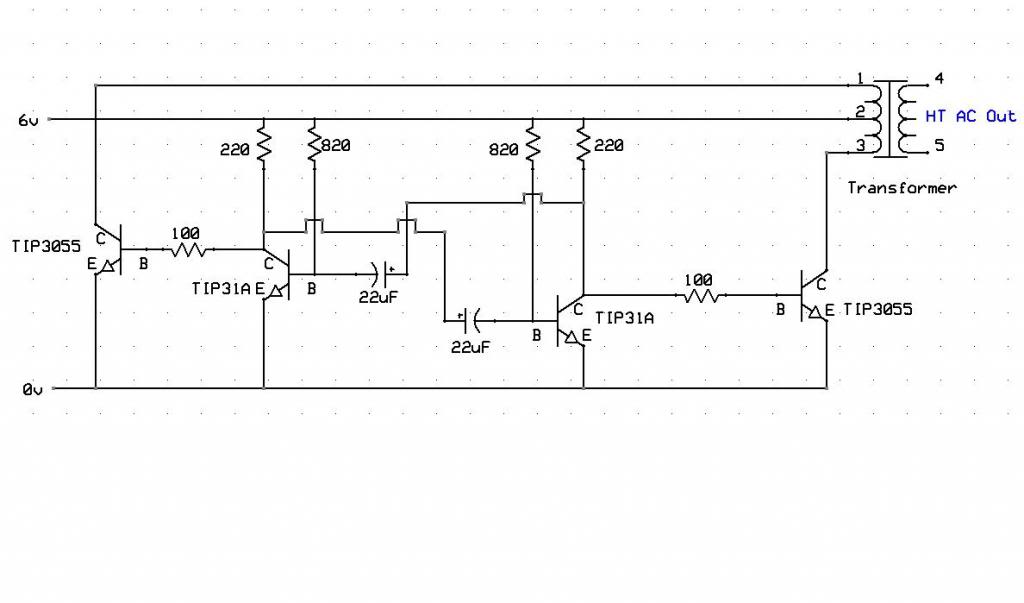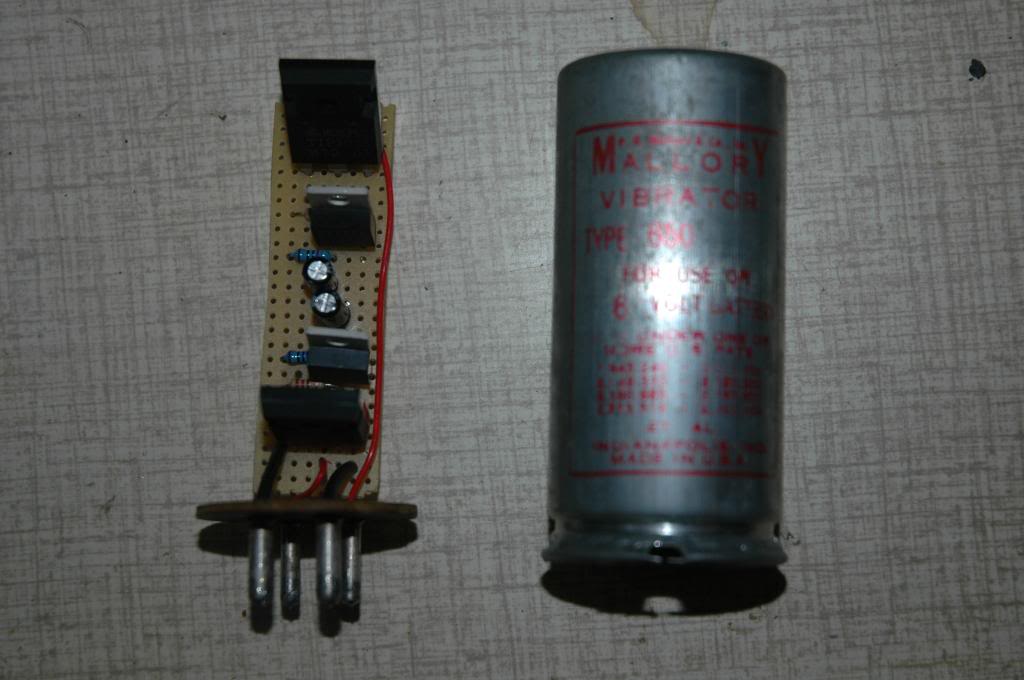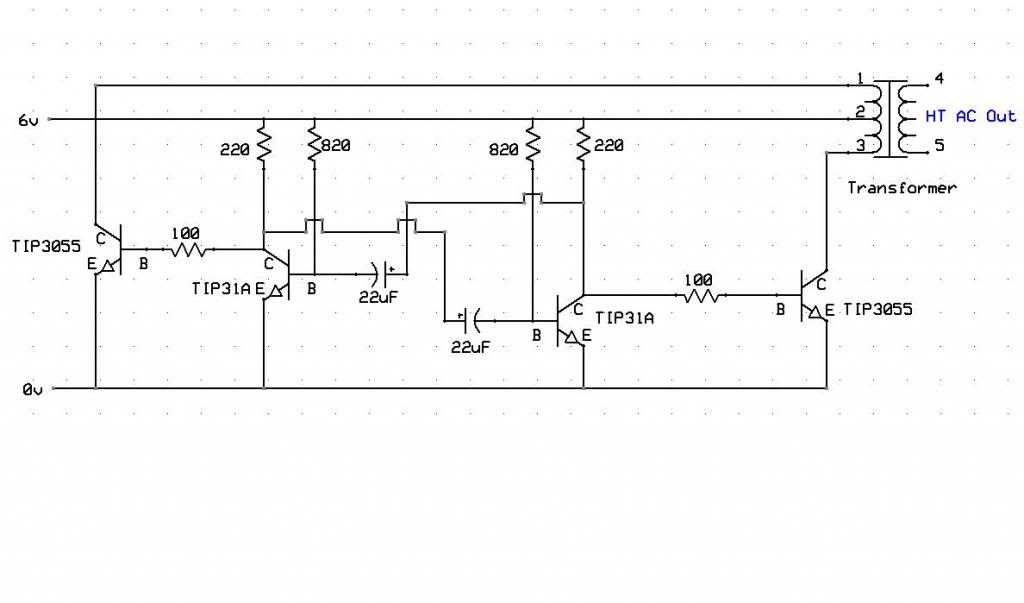Posts: 6
Threads: 1
Joined: Nov 2013
City: UK
Hi
I am new to this forum, I have recently acquired, what I believe to be a BV-613 World War 2 General Broadcast Receiver used by the British Army.
There are several problems with the Power supply unit
So...
Does anyone have a circuit diagram for this radio ?
The radio is powered by a 6V DC battery, HT is supplied using an Mallory 650 vibrator and a 6X5 common cathode rectifier. (I will probably re-pot the vibrator with a solid state vibrator as I have done previously)
I like to change the old paper capacitors as a matter of course, this is where my first problem lies.
There are two capacitors labelled PT. No. 4522D, these are can type with the case being one connection and the lead for the other, what is the capacitance of these ?
The other is a multi capacitor in a single can has 6 tags , 3 common tags to the body and 3 separate tags
Phiclo part number 61-0028S
Other markings are
10-350 (with a square symbol next to it) I assume this is 10mF 350V
10-330 (with a triangle symbol next to it) I assume that this is also 10mF 350V
20-25 CAN NEG (20mF from where ? to CAN)
what is the pinout/internal layout of this capacitor
Thanks
Richard (in the UK)
Posts: 1,106
Threads: 88
Joined: Jun 2011
City: Tacoma
State, Province, Country: Washington
Richard,
If you look at the bottom of your capacitor, along the outside of each of the positive terminals, you'll see the same representative symbols at each terminal. Sometimes you have to look carefully, but you will see the little square and triangle, these use the terminal as one side of the symbol.
As far as the 4522D's, I can't find any reference to those. But these are likely paper caps. I've seen several values of that style (if these are the ones with the mounting lug). Perhaps Ron may know the values on these.
Posts: 6
Threads: 1
Joined: Nov 2013
City: UK
Thanks for the information
I have found the square and triangle marks on the three insulated lugs on the 61-0028S
My capacitance meter is struggling with measurements, these are erratic and nowhere near what I think they should be, are the three lugs on the can supposed to be common ? The dimensions of this capacitor are 1” diameter with a 2” body. I assume that this is an electrolytic ?. I will do some further leakage test at 350V DC tomorrow..
The two capacitors labelled PT. No. 4522D dimensions are 1” diameter 2” long. Capacitance readings are 1.22mF and 1.3mF. I am sure that these are paper ones.
The idea is to repot these with new capacitors as I like to get internal looking correct
I will keep the forum posted with progress and up load some photos
Thanks
Richard
Posts: 1,106
Threads: 88
Joined: Jun 2011
City: Tacoma
State, Province, Country: Washington
Sounds like those 4522D's were originally 1.0 uf. Use 630V replacements.
Posts: 6
Threads: 1
Joined: Nov 2013
City: UK
Thanks for all the information. Thought I had better give an update as to how things were getting on.
What I have is actually a Philco Reception Set BV-611 , Frequency Coverage 200-500kHz
I have the manual an circuit diagram so things have progressed.
The Power Supply section has been re-built (old capacitors re-potted with modern ones). The Mallory 650 vibrator has been converted to a solid state version that fits in the old can and is pin compatible.
HT is good and solid at 280V, with wave forms in and out of the transformer looking good (no nasty spikes)
I still have to replace a few old capacitors as these are well outside spec and are a bit leaky.
My main problem is that the bench supply I use can only supply 2A at 6V and the set will need appx 4.8A, so new bench PSU to be built/bought. A couple of photos attached to show what I have done:


Cheers
Richard
Posts: 2,128
Threads: 18
Joined: Oct 2008
City: Merrick, Long Island, NY
Well, replace the rest of the waxies first as well as the carbon resistore that have drifted high, or just all of 'em at pennies apiece. 6.3 volt secondary transformers (whether combined with other windings,) are available (usually just over scrap copper value) for testing purposes. Come back with more!
Posts: 1,113
Threads: 14
Joined: Feb 2013
City: Irvington, NY
That solid state vibrator replacement looks very interesting. Do you have a schematic and parts list for it?
I have a couple of 6V car radios that need vibrators and your replacement would be a good solution.
Posts: 6
Threads: 1
Joined: Nov 2013
City: UK
Hi
This is the solid state inverter I use a fair bit. It works well, you will have to play with values of the capacitors as the waveform/frequency is partially dependent of the inductance of the transformer and the capacitors. The power transistors TIP3055 will not run hot if you get a good waveform. This arrangement can be fitted into the old can of the vibrator. Be careful to get the correct pin connections on the vibrator. Simple to make and very reliable. You can model this using Ltspice or similar, for modelling purposes make sure that the resistor values are all slightly different but within say 5% tolerance, if you don't do this then the circuit will not oscillate. The 20uF caps shown in the circuit are what I used in this instance
I seem to recall that the switching frequency of a Mallory Vibrator is appx 40Hz, when in circuit in the BV611 the vibrator give about 45Hz.
Let me know how you get on

Cheers
Richard
PS If you are interested I will post a very simple 1 transistor HT power supply design, that draws 'zero' current when there is no load.
Posts: 15,299
Threads: 531
Joined: Oct 2011
City: Jackson, NJ
The calculated frequency of this is about 39.7 Hz, but then your caps which are lytics are probably at least 20% tolerance hence your deviation.
Also, the transformer here presents sheer inductance when not loaded, so driving it with switching transistor can present (potentially) a danger of killing the transistor unless each half is shunted with a reverse-biased diode (pretty much as DC relays are). When loaded it is not a problem but then you never know when you accidentally power it unloaded. A snubber wouldn't hurt either.
If it were a sinewave gen that'd be fine but this is a multivibrator.
(This post was last modified: 12-20-2013, 01:42 PM by morzh.)
Posts: 6
Threads: 1
Joined: Nov 2013
City: UK
Hi morzh
Points noted, the idea of this is a direct replacement for a mallory 650 and it fits in the can. The 3055's are pretty robust, I havn't blown one up yet. The transformer was included to show the correct connections for the vibrator.
Mallory 650's are hard to come by in the UK, what design do you use for a solid state vibrator ?.
Cheers
Richard
Posts: 1,113
Threads: 14
Joined: Feb 2013
City: Irvington, NY
Thanks for posting the schematic. Looks easy to build and I have all the parts needed, so I may give it a try.
I have a feeling that the switching freq may be a bit low though. From what I understand, Mallory used a standard frequency of 115 Hz for its vibrators. This higher freq was to minimize the size and weight of the core needed for the transformer.
Here is a PDF of the Mallory design manual for vibrator power supplies. It gives more info than I have ever seen in one place regarding their engineering and use. Frequency of operation is discussed beginning on page 19.
Interesting reading, and helpful info for the design of a modern solid state replacement.
http://www.tubebooks.org/Books/mallory_vibe.pdf
Posts: 6
Threads: 1
Joined: Nov 2013
City: UK
Hi
Just been checking frequencies, with the design above it is 78Hz, this compares favourably with my simulation (84Hz). I must have misread my initial measurement. Thanks for the information on Mallory vibrators (will make good Christmas reading), after a bit of playing with values, my model shows a that if the two 820 Ohm resistors are changed to 620 Ohms then the frequency should be 118Hz, after a quick mod a frequency of 102Hz was measured.
Will have to make a few more checks as current is a tad high, time to check for more leaky caps (need to check the single can that holds 4 paper caps). More to follow after the Christmas break
Cheers
Richard
Posts: 1,113
Threads: 14
Joined: Feb 2013
City: Irvington, NY
One thing I have been thinking of is replacing the 3055's with IRF1010N power mosfets. The 3055's have a saturation voltage of over 1.1 V at a collector current of 4 Amps, which amounts to a lot of heat dissipation, more than 4 watts combined. The 1.1 V of drop also becomes pretty significant when you are starting out with only 6 V of supply.
The mosfets have an on resistance of only .011 Ohm, so total power dissipated drops to .176 watt at the same 4 A current. This is probably better than the original mechanical contacts as far as loss is concerned.
Might be worth giving a try...?
(This post was last modified: 12-21-2013, 08:03 PM by Mondial.)
Posts: 2
Threads: 0
Joined: Aug 2017
City: London, UK
Hello All - my name is David and I'm a collector / restorer of WW2 wireless equipment based about 15 miles NE of London UK. I'm also a keen Radio Amateur using and displaying the equipment at various public events throughout the year.
I've just been asked by a fellow Ham to restore a BV-613. I can see from this thread I'm not the first! Would it be possible please for someone to share the circuit diagram?
I can restore without on the basis of what I'm seeing in the box but there's a risk components have been removed and / or modifications made so always prefer to have the circuit to hand.
Best wishes and 73's
David
M0IDF
Posts: 5,004
Threads: 267
Joined: Nov 2012
City: Bandon
State, Province, Country: OR
Welcome to the Phorum David!

Users browsing this thread: 1 Guest(s)
|



